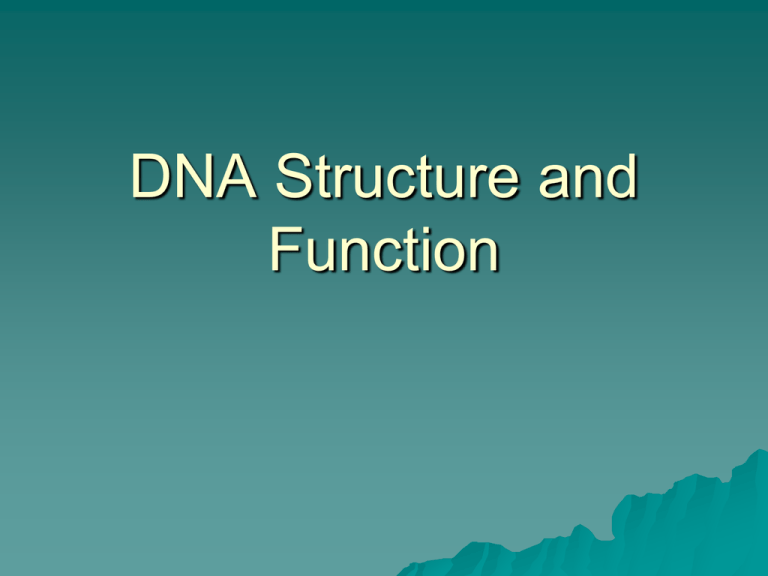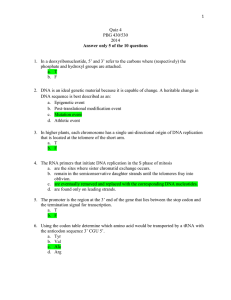DNA Structure and Function
advertisement

DNA Structure and Function I) DNA Structure Polymer = nucleic acid Monomer = nucleotide (has 3 parts ) 1)Sugar: Deoxyribose 5 carbon ring results in a 5’ and 3’ ends of sugar. DNA Structure Cont’d 2)Phosphate: Connected to the 5’ end of sugar and will bond to the 3’ end of another deoxyribose sugar on another nucleotide Results in the phosphate-sugar backbone. DNA Structure Cont’d 3) Nitrogen Base: (polar) 2 classes – Purines = 2 nitrogenous rings – Pyrmidines = 1 nitrogenous ring – Thymine (T): 2 H-bonds possible Cytosine (C): 3 H-bonds possible Purines bind to Pyrmidines that have the same number of H-bonds Adenine (A): 2 H-bonds possible Guanine (G): 3 H-bonds possible A–T/T–A C–G/G–C DNA has two strands that will be antiparallel II) DNA Function Replication: DNA copied to make more DNA (s phase; sister chromatids) - When finished each sister chromatid has 1 old strand and 1 new strand = Semi-conservative replication. DNA Function: Replication Process: Unwinding = Helix is uncoiled and Hbonds b/w bases are broken (unzipped). – Done by enzyme Helicase Base Pairing = new complimentary bases are added to old DNA strand – Done by DNA Polymerase Joining = Phosphate of one new nucleotide bonds to 3’ of other sugar. Replication Cont’d Problem: DNA polymerase binds (builds) nucleotides 5’ 3’ What happens on the original 3’ 5’ DNA strand? Leading Strand: New 5’ 3’ DNA synthesized continuously towards replication fork. (faster) Lagging Strand: on the old 5’ 3’ DNA. 5’3’ DNA fragments built by many DNA polymerases away from replication fork = Okazaki fragments (slower) – Enzyme ligase connects the fragments together. How Genes Work > 3 million species discovered; differ by genes (sequence of nucleotide bases). How does a difference in base sequences cause uniqueness of species? DNA sequence of nucleotides sequence of amino acids specific proteins specific varieties of anatomy and physiology Modern Ideas Gene: sequence of DNA nucleotide bases that codes for a product. Problem: DNA in nucleus (can’t leave; too big). Protein made in ribosomes in cytoplasm; how is the message sent? RNA Gene does not affect phenotype directly; gene product affects the phenotype Nucleic acid Differences: – Single stranded – Ribose – Uracil instead of Thymine Types – Messenger RNA (mRNA): sends code from DNA to ribosomes – Transfer RNA (tRNA): brings amino acids to ribosomes – Ribosomal RNA (rRNA): Part of Ribosomes (along with proteins) Gene Expression has 2 Steps 1. 2. Transcription: DNA template for RNA formation; mRNA then moves to the cytoplasm. Translation: mRNA directs the sequence of Amino acids in a polypeptide (protein). DNA Function: Protein Synthesis Genetic Code: 20 amino acids build all of life’s proteins. Has to be a system to code for them using only 4 bases on DNA Codon: 3 consecutive bases on mRNA that code for a specific amino acid. Properties: Degenerate: Most amino acids have more than 1 codon Has a beginning and end ( 1 start codon; 3 stop codons) Unambiguous: 1 code = 1 meaning Universal: all living things obey this code Therefore this dates back to 1 life on this planet. All living things are related. A tobacco plant expressing a firefly gene. Because diverse forms of life share a common genetic code, it is possible to program one species to produce proteins characteristic of another species by transplanting DNA. In this experiment, researchers were able to incorporate a gene from a firefly into the DNA of a tobacco plant. The firefly gene codes for an enzyme that catalyzes a chemical reaction that releases light energy. 1) Transcription (nucleus) Helicase unzips DNA (same as replication) RNA Polymerase (not DNA Polymerase) binds RNA nucleotides Also builds in the 5’ 3’ direction Connects @ Promoter = segment on the DNA that defines the start of a gene, the direction of transcription. Terminator = segment of DNA that defines the end of a gene. Stops RNA polymerase. 1) Transcription (nucleus) New mRNA = Primary mRNA transcript Needs to be modified before it can leave the nucleus. 1. Ends protected: 5’ = modified Guanine (Cap) 3’ = 150 – 200 Adines attached (poly A tail)\ Inhibits degradation (friction) 2. Introns removed; mRNA that is never expressed Exons = RNA that is actually expressed Done by Splicesomes 3. Mature mRNA transcript Cytoplasm 2) Translation (cytoplasm) Message in 1 language (nucleic acid) translated into another language (protein). tRNA: single stranded, but doubled back on itself. Anticodon=3 bases that complimentary base pair to mRNA. Amino acid binds to the 3’ end. 2) Translation (cytoplasm) rRNA: combined w/variety of proteins into subunits 1 large & 1 small subunit. Sm. subunit has site for mRNA. Lg. subunit has 3 sites for tRNA complexes. (E,P, and A sites) If lots of protein product is needed many ribosomes may bind to 1 mRNA molecule = Polyribosome Translation Requires 3 steps 1. Initiation: energy/enzymes required Small subunit binds to mRNA @ AUG codon. 1st tRNA binds its anticodon Large subunit binds to small so that tRNA is in the P site. Translation Requires 3 steps 2. Elongation: energy/enzymes required tRNA already in P site; proper tRNA arrives @ A site. Amino Acid from tRNA #1 is transferred and bound (peptide) to new amino acid on tRNA #2. Translocation occurs: ribosome moves down mRNA thus shifting the tRNA’s so that 1st one is now in E site and 2nd one is now in P site. tRNA in E site leaves ribosome and A site is now empty will bind the 3rd tRNA. Process occurs until ribosome reaches stop codon. Translation Requires 3 steps 3. Termination: Occurs @ stop codon Release factor (enzyme) cleaves polypeptide from last tRNA which then leaves P site. Subunits dissociate. Polypeptide may function on own, become part of larger protein, and if ribosome is on the ER then it gets ready to leave the cell. Coupled transcription and translation in bacteria. In prokaryotic cells, the translation of mRNA can begin as soon as the leading (5′) end of the mRNA molecule peels away from the DNA template. Attached to each RNA polymerase molecule is a growing strand of mRNA, which is already being translated by ribosomes. The newly synthesized polypeptides are not visible in the micrograph but are shown in the diagram.







